-
 Integrating Genomics and Molecular Biology in Understanding Peritoneal Adhesion
Integrating Genomics and Molecular Biology in Understanding Peritoneal Adhesion -
 Galectin-3 in Cardiovascular Health—Review
Galectin-3 in Cardiovascular Health—Review -
 ELK1, c-Jun, and STAT3 Mediate Bortezomib Resistance in Prostate Cancer Cells
ELK1, c-Jun, and STAT3 Mediate Bortezomib Resistance in Prostate Cancer Cells -
 Angelica keiskei Extract in Hepatocellular Carcinoma
Angelica keiskei Extract in Hepatocellular Carcinoma -
 CRISPR-Cas9 in the Tailoring of Genetically Engineered Animals
CRISPR-Cas9 in the Tailoring of Genetically Engineered Animals
Journal Description
Current Issues in Molecular Biology
Current Issues in Molecular Biology
is an international, scientific, peer-reviewed, open access journal on molecular biology, published monthly online by MDPI (from Volume 43 Issue 1-2021).
- Open Access— free for readers, with article processing charges (APC) paid by authors or their institutions.
- High Visibility: indexed within Scopus, SCIE (Web of Science), PMC, PubMed, Embase, CAPlus / SciFinder, FSTA, AGRIS, and other databases.
- Rapid Publication: manuscripts are peer-reviewed and a first decision is provided to authors approximately 17.8 days after submission; acceptance to publication is undertaken in 2.7 days (median values for papers published in this journal in the first half of 2025).
- Recognition of Reviewers: APC discount vouchers, optional signed peer review, and reviewer names are published annually in the journal.
Impact Factor:
3.0 (2024);
5-Year Impact Factor:
3.2 (2024)
Latest Articles
Pharmacological Evaluation of Polygoni Multiflori Radix Praeparata Extract: Inhibition of PANoptosis in Alleviating Premature Ovarian Insufficiency
Curr. Issues Mol. Biol. 2025, 47(7), 569; https://doi.org/10.3390/cimb47070569 (registering DOI) - 19 Jul 2025
Abstract
Polygoni Multiflori Radix Praeparata (PMRP), a processed root of Polygonum multiflorum Thunb. (known as Zhiheshouwu in Chinese medicine), exhibits anti-aging properties and is used to improve ovarian aging. However, its therapeutic mechanism against premature ovarian insufficiency (POI) remains unclear. This study investigates whether
[...] Read more.
Polygoni Multiflori Radix Praeparata (PMRP), a processed root of Polygonum multiflorum Thunb. (known as Zhiheshouwu in Chinese medicine), exhibits anti-aging properties and is used to improve ovarian aging. However, its therapeutic mechanism against premature ovarian insufficiency (POI) remains unclear. This study investigates whether PMRP alleviates POI by inhibiting PANoptosis—a cell death pathway characterized by the concurrent occurrence and interplay of pyroptosis, apoptosis, and necroptosis. POI was induced in rats using tripterygium glycosides. We evaluated the estrous cycle, serum hormone levels (follicle-stimulating hormone [FSH], estrogen [E2], anti-Müllerian hormone [AMH]), follicular development, and the ultrastructure of granulosa cells. PANoptosome assembly (apoptosis-associated speck-like protein containing a CARD [ASC]/caspase-8/receptor-interacting protein kinase 3 [RIPK3] co-localization) and key effectors of PANoptosis (caspase 3, cleaved caspase 3, gasdermin D [GSDMD], cleaved GSDMD, GSDME, RIPK1, mixed-lineage kinase domain-like protein [MLKL], and p-MLKL) were analyzed. PMRP restored the estrous cycle, lowered FSH levels, and increased E2 and AMH levels in POI rats. It reduced follicular atresia, preserved primordial follicles, and suppressed PANoptosis-like death in granulosa cells. Mechanistically, PMRP disrupted PANoptosome assembly and downregulated key effectors of PANoptosis. PMRP alleviates POI by inhibiting PANoptosis in granulosa cells, overcoming the previous limitations of targeting single death pathways and providing novel insights into the pathogenesis and treatment strategies for POI.
Full article
(This article belongs to the Section Molecular Pharmacology)
►
Show Figures
Open AccessArticle
Oral Squamous Cell Carcinoma Exosomes Upregulate PIK3/AKT, PTEN, and NOTCH Signaling Pathways in Normal Fibroblasts
by
Dijana Mitic, Milica Jaksic Karisik, Milos Lazarevic, Jelena Carkic, Emilia Zivkovic, Olivera Mitrovic Ajtic and Jelena Milasin
Curr. Issues Mol. Biol. 2025, 47(7), 568; https://doi.org/10.3390/cimb47070568 (registering DOI) - 19 Jul 2025
Abstract
Exosomes, small extracellular vesicles secreted by various cell types, have gained significant attention in cancer investigations. Isolation and characterization of exosomes derived from DOK (dysplastic oral keratinocyte), SCC (squamous cell carcinoma) and HaCaT (normal skin keratinocyte) cell lines and microRNA profiling were conducted.
[...] Read more.
Exosomes, small extracellular vesicles secreted by various cell types, have gained significant attention in cancer investigations. Isolation and characterization of exosomes derived from DOK (dysplastic oral keratinocyte), SCC (squamous cell carcinoma) and HaCaT (normal skin keratinocyte) cell lines and microRNA profiling were conducted. Magnetic sorting was applied to obtain pure exosomes. Morphology and size were characterized by transmission electron microscopy and nanoparticle tracking analysis. Validation of membrane exosomal markers (CD9, CD63) was performed via Western blotting. MiR-21, miR-31, and miR-133 levels were analyzed in exosomes and parent cells by qPCR. Biological effects of the exosomes were tested by adding them to fibroblast cultures and determining the expression of relevant carcinogenesis markers by qPCR. Exosomes appeared as cup-shaped nano-sized particles, and there was no difference regarding particle diameter and concentration between the three types of exosomes. The oncogenic miR-21 was significantly upregulated both in SCC and SCC-derived exosomes compared to DOK and HaCaT cells and their respective exosomes. However, miR-31 unexpectedly showed the highest expression in normal cells and the lowest in HaCaT exosomes. MiR-133, the tumor suppressor miRNA, was downregulated in both SCC and DOK cells compared to normal (HaCaT) cells, while the opposite situation was observed in exosomes, with HaCaT cells showing the lowest levels of miR-133. The differences in exosome content were reflected in signaling pathway activation in exosome-treated fibroblasts, with SCC exosomes exerting the most potent effect on several cancer-related pathways, notably PIK3/AKT, PTEN, and NOTCH signaling cascades.
Full article
(This article belongs to the Special Issue The Significance of Transcription Factors, miRNAs, and lncRNAs in Anticancer Drug Development)
►▼
Show Figures

Figure 1
Open AccessArticle
Photoprotective Effects of Quercetin and Hesperidin in Polymorphous Light Eruption: A Comparative Study with Alpha-Glucosylrutin
by
Yoon-Seo Choi, Sang-Hoon Park, Inhee Jung, Eun-Ju Park, Wonki Hong, Jin-Hee Shin, Won-Sang Seo and Jongsung Lee
Curr. Issues Mol. Biol. 2025, 47(7), 567; https://doi.org/10.3390/cimb47070567 (registering DOI) - 19 Jul 2025
Abstract
Polymorphous Light Eruption (PLE) is a prevalent UV-induced photodermatosis characterized by abnormal immune responses, oxidative stress, and cutaneous inflammation. Alpha-glucosylrutin (AGR), a chemically modified flavonoid widely used for its antioxidant and photoprotective effects, has shown clinical efficacy; however, its synthetic origin and classification
[...] Read more.
Polymorphous Light Eruption (PLE) is a prevalent UV-induced photodermatosis characterized by abnormal immune responses, oxidative stress, and cutaneous inflammation. Alpha-glucosylrutin (AGR), a chemically modified flavonoid widely used for its antioxidant and photoprotective effects, has shown clinical efficacy; however, its synthetic origin and classification as a potential skin sensitizer and aquatic toxin raise safety and environmental concerns. These limitations underscore the need for safer, naturally derived alternatives. In this study, we investigated the comparative efficacy of quercetin (QC) and hesperidin (HPN)—two plant-based flavonoids—against AGR in in vitro and ex vivo models of sun-induced skin damage. An optimized QC:HPN 8:1 (w/w) complex significantly restored antioxidant enzyme activities (SOD: 4.11 ± 0.32 mU/mg; CAT: 1.88 ± 0.04 mU/mg) and suppressed inflammatory cytokine production (IL-6: 155.95 ± 3.17 pg/mL; TNF-α: 62.34 ± 0.72 pg/mL) more effectively than AGR. β-hexosaminidase secretion, a marker of allergic response, was reduced to 99.02 ± 1.45% with QC:HPN 8:1, compared to 121.33 ± 1.15% with AGR. QC alone exhibited dose-dependent cytotoxicity at ≥10 μg/mL, whereas HPN maintained >94% cell viability at all tested concentrations. These findings highlight the QC:HPN 8:1 complex as a safe, natural, and effective alternative to synthetic AGR for preventing and managing PLE and UV-induced dermal inflammation. Further research should focus on clinical validation and formulation development for topical use.
Full article
(This article belongs to the Special Issue Molecular Research in Bioactivity of Natural Products, 3rd Edition)
►▼
Show Figures

Figure 1
Open AccessBrief Report
The Isoforms of Ral Guanine Nucleotide Dissociation Stimulator (RalGDS) in LLC-PK1 Cells
by
Jingze Song, Na Li, Xinze Dong, Jianping Xie, Hongqiao Lai, Hengzhi Zhu, Kongwang He, Libin Wen, Sizhu Suolang and Qi Xiao
Curr. Issues Mol. Biol. 2025, 47(7), 566; https://doi.org/10.3390/cimb47070566 - 18 Jul 2025
Abstract
This study investigated the isoforms of porcine-origin Ral guanine nucleotide dissociation stimulator (RalGDS) in LLC-PK1 cells using reverse transcription-polymerase chain reaction (RT-PCR) and sequencing. Through segmented amplification, sequence assembly, and comparative genomics analysis, seven RalGDS isoforms were identified, characterized by insertions, deletions, and
[...] Read more.
This study investigated the isoforms of porcine-origin Ral guanine nucleotide dissociation stimulator (RalGDS) in LLC-PK1 cells using reverse transcription-polymerase chain reaction (RT-PCR) and sequencing. Through segmented amplification, sequence assembly, and comparative genomics analysis, seven RalGDS isoforms were identified, characterized by insertions, deletions, and frameshift mutations. These genetic variations may significantly alter RalGDS’s protein structure and function, potentially impacting its role in Ral GTPase-mediated signaling pathways. This work provides foundational insights into the genetic diversity of porcine RalGDS and its implications for porcine physiology and economically significant traits.
Full article
(This article belongs to the Section Biochemistry, Molecular and Cellular Biology)
Open AccessReview
Lipid Hormones at the Intersection of Metabolic Imbalances and Endocrine Disorders
by
Maria-Zinaida Dobre, Bogdana Virgolici and Ruxandra Cioarcă-Nedelcu
Curr. Issues Mol. Biol. 2025, 47(7), 565; https://doi.org/10.3390/cimb47070565 - 18 Jul 2025
Abstract
Lipid hormone imbalances involving glucocorticoids, thyroid hormones (THs), and sex hormones have widespread metabolic consequences, contributing to the global increase in obesity and insulin resistance. This review examines the complex role of disrupted lipid hormone pathways in the development of metabolic disorders, particularly
[...] Read more.
Lipid hormone imbalances involving glucocorticoids, thyroid hormones (THs), and sex hormones have widespread metabolic consequences, contributing to the global increase in obesity and insulin resistance. This review examines the complex role of disrupted lipid hormone pathways in the development of metabolic disorders, particularly metabolic dysfunction-associated steatotic liver disease (MASLD). Endocrine disorders such as hypercortisolism, hypothyroidism, and polycystic ovary syndrome (PCOS) are closely linked to MASLD through shared metabolic pathways. Mechanisms include glucocorticoid-induced gluconeogenesis and lipolysis, impaired lipid clearance in hypothyroidism, and the hyperandrogenism-induced downregulation of hepatic low-density lipoprotein (LDL) receptors. PCOS-related factors—such as central obesity, adipocyte hypertrophy, low adiponectin levels, and genetic predisposition—further promote hepatic steatosis. Thyroid dysfunction may also impair the hepatic deiodination of T4, contributing to lipid accumulation and inflammation. Given the overlapping pathophysiology among endocrine, hepatic, and reproductive disorders, multidisciplinary collaboration is essential to optimize diagnosis, treatment, and long-term cardiometabolic outcomes.
Full article
(This article belongs to the Special Issue Molecular Mechanisms Underlying Fatty Liver Disease: From Pathogenesis to Treatment, 2nd Edition)
►▼
Show Figures
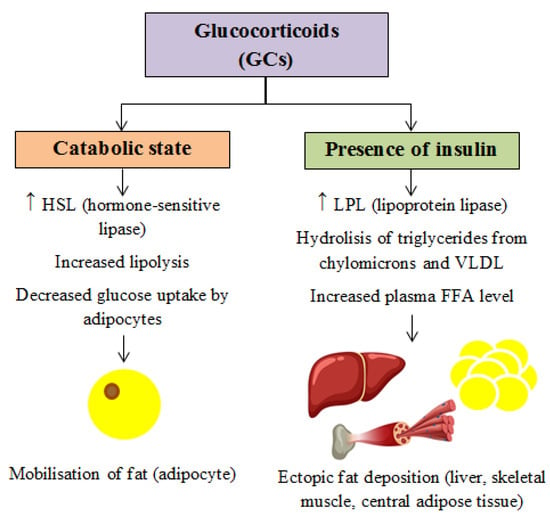
Figure 1
Open AccessCommunication
Establishment of an Assay with Ultrahigh Sensitivity for Detecting sEV-Derived PD-L1 as a Serum Biomarker for Lung Cancer—A Pilot Study Using TN-cyclon™
by
Kyo Okita, Hasumi Arita, Keita Sudo, Teruki Yoshimura and Etsuro Ito
Curr. Issues Mol. Biol. 2025, 47(7), 564; https://doi.org/10.3390/cimb47070564 - 18 Jul 2025
Abstract
Programmed death-ligand 1 (PD-L1) is an immune checkpoint protein. The soluble form of PD-L1 (sPD-L1) and PD-L1 derived from small extracellular vesicles (sEVPD-L1) are promising cancer biomarkers. While sEVPD-L1 in particular may contribute to immune evasion and is associated with a poor prognosis,
[...] Read more.
Programmed death-ligand 1 (PD-L1) is an immune checkpoint protein. The soluble form of PD-L1 (sPD-L1) and PD-L1 derived from small extracellular vesicles (sEVPD-L1) are promising cancer biomarkers. While sEVPD-L1 in particular may contribute to immune evasion and is associated with a poor prognosis, it exists only in trace amounts, making it difficult to detect using conventional enzyme-linked immunosorbent assay (ELISA) methods. Therefore, we developed an ultrasensitive detection method, TN-cyclon™. The TN-cyclon™ method combines sandwich ELISA with enzyme cycling amplification. We applied TN-cyclon™ to measure recombinant PD-L1 protein and sEVPD-L1 in serum samples from cancer patients and healthy donors. Recombinant PD-L1 protein was measured with an ultrasensitive detection limit of 0.172 pg/mL. In clinical specimens, sEVPD-L1 levels were significantly higher in lung cancer patients than in healthy donors, whereas sPD-L1 levels measured with a conventional ELISA did not differ significantly between groups. Our results demonstrated that the TN-cyclon™ method exhibits a 20-fold increase in sensitivity compared to a conventional ELISA. Although this is a pilot study, our new assay enables the detection of very low concentrations of sEVPD-L1 in serum that can be used to evaluate the predictive and prognostic performance of sEVPD-L1 in lung cancer patients in future studies.
Full article
(This article belongs to the Special Issue Cancer Biomarkers: Discovery and Applications)
►▼
Show Figures
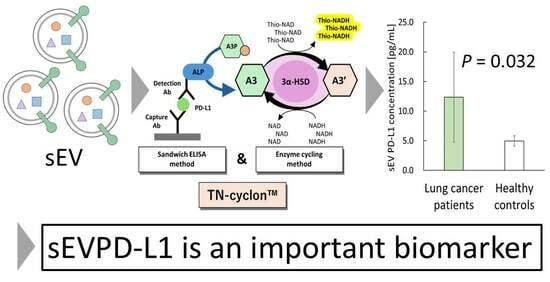
Graphical abstract
Open AccessArticle
CTC-537E7.3 as a Liver-Specific Biomarker for Hepatocellular Carcinoma: Diagnostic and Prognostic Implications
by
Hyung Seok Kim, Se Ha Jang, Geum Ok Baek, Moon Gyeong Yoon, Jaewon Shim, Ji Eun Han, Soon Sun Kim, Jae Youn Cheong and Jung Woo Eun
Curr. Issues Mol. Biol. 2025, 47(7), 563; https://doi.org/10.3390/cimb47070563 - 18 Jul 2025
Abstract
Hepatocellular carcinoma (HCC) critically lacks reliable biomarkers for early detection. By mining the TCGA_LIHC and two GEO cohorts, we identified the liver-specific long non-coding RNA CTC-537E7.3 as the most consistently down-regulated transcript in tumors. This finding was validated in 97 paired tissues, with
[...] Read more.
Hepatocellular carcinoma (HCC) critically lacks reliable biomarkers for early detection. By mining the TCGA_LIHC and two GEO cohorts, we identified the liver-specific long non-coding RNA CTC-537E7.3 as the most consistently down-regulated transcript in tumors. This finding was validated in 97 paired tissues, with CTC-537E7.3 expression lost in 95% of cases (*** p < 0.0001). It demonstrated excellent diagnostic performance in discriminating tumor from non-tumor tissue (AUC = 0.95), which was maintained in early-stage (I/II) disease. Low CTC-537E7.3 expression correlated with shorter overall and disease-free survival and was inversely associated with serum α-fetoprotein (AFP) levels, highlighting its complementary clinical value. Mechanistic investigation revealed a potential competing endogenous RNA (ceRNA) axis. The microRNA miR-190b-5p was highly expressed in tumors and predicted to bind CTC-537E7.3, while its target, PLGLB1, was significantly suppressed. Survival analysis confirmed that concurrent high expression of CTC-537E7.3 and PLGLB1 conferred superior outcomes. These findings establish CTC-537E7.3 as a liver-specific, ceRNA-mediated tumor suppressor with robust diagnostic and prognostic potential. It represents a promising adjunct to existing HCC surveillance strategies, such as ultrasound and AFP measurement, for high-risk populations.
Full article
(This article belongs to the Special Issue Epigenetic Changes in Cancer: Mechanisms, Biomarkers, and Therapeutic Strategies)
►▼
Show Figures
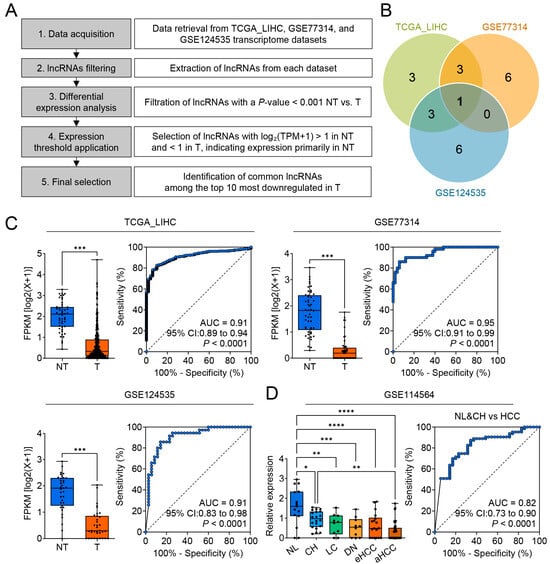
Figure 1
Open AccessArticle
High-Fat/High-Sugar Diet and High-Temperature/High-Humidity Exposure Aggravates Ulcerative Colitis in an Experimental Mouse Model
by
Pengyan Li, Guibing Meng, Ang Li, Liang Chen, Xinchi Feng and Feng Qiu
Curr. Issues Mol. Biol. 2025, 47(7), 562; https://doi.org/10.3390/cimb47070562 - 18 Jul 2025
Abstract
Ulcerative colitis (UC) is a subtype of inflammatory bowel disease (IBD) that has been associated with overconsumption of calories and lipids, compared to the healthy population, and summer temperatures have been reported to be closely related to the prevalence of UC. To evaluate
[...] Read more.
Ulcerative colitis (UC) is a subtype of inflammatory bowel disease (IBD) that has been associated with overconsumption of calories and lipids, compared to the healthy population, and summer temperatures have been reported to be closely related to the prevalence of UC. To evaluate the effects of dietary and lifestyle factors on UC, a combination of 2.0% dextran sulfate sodium (DSS), a high-fat/high-sugar diet, and exposure to high temperature and humidity was used to construct mouse models of UC. Changes in body weight, disease activity index (DAI) scores, histopathological analysis, serum lipid levels, serum diamine oxidase (DAO), and D-Lactate (D-LA) levels, as well as the expression of inflammatory cytokines and tight junction proteins in colonic tissue, were all assessed to study the impacts of the high-fat/high-sugar diet and high-temperature/high-humidity exposure on the progression of UC. The symptoms observed in the UC mouse model induced by 2.0% DSS alone were similar to those seen in patients with UC, while the high-fat and high-sugar diet, along with humid and hot exposure, exacerbated DSS-induced UC in the mice. This included more severe histopathological damage to the colon tissue, increased expression of pro-inflammatory cytokines (IL-6, IL-17A, and IL-1β), and a more significantly compromised intestinal barrier, characterized by the destruction of ZO-1 and elevated levels of DAO and D-LA. Additionally, the high-fat/high-sugar diet and high-temperature/high-humidity exposure led to further disturbances in glucose and lipid metabolism in the mice, which were not observed in those treated with DSS alone. This study is the first to investigate the effects of a high-fat/high-sugar diet and high-temperature/high-humidity exposure on the progression of UC.
Full article
(This article belongs to the Section Molecular Pharmacology)
►▼
Show Figures
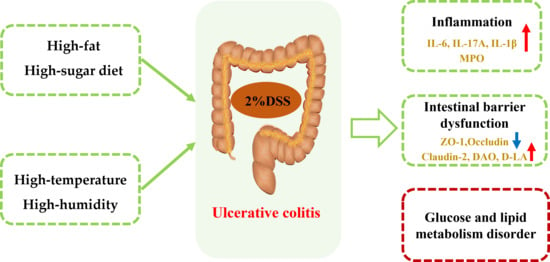
Graphical abstract
Open AccessReview
The Aging Lung: Exploring Multimorbidity Patterns and Their Clinical Implications: A Narrative Review
by
Ali Albarrati and Nichola S. Gale
Curr. Issues Mol. Biol. 2025, 47(7), 561; https://doi.org/10.3390/cimb47070561 - 18 Jul 2025
Abstract
Aging is a multifaceted biological process characterized by a progressive decline in cellular function and physiological resilience, increasing the risk of multiple chronic conditions. Chronic lung diseases frequently manifest within the aging population and are closely intertwined with systemic dysfunctions across cardiovascular, musculoskeletal,
[...] Read more.
Aging is a multifaceted biological process characterized by a progressive decline in cellular function and physiological resilience, increasing the risk of multiple chronic conditions. Chronic lung diseases frequently manifest within the aging population and are closely intertwined with systemic dysfunctions across cardiovascular, musculoskeletal, and neurological systems. In this review, we explore the biological mechanisms linking aging, multiple chronic conditions patterns, and chronic lung disease, with a particular focus on inflammaging and cellular aging. We also highlight shared pathological pathways such as oxidative stress, mitochondrial dysfunction, and the dysregulation of repair processes that underlie both natural aging and the accelerated aging seen in chronic lung disease. Additionally, we discuss the systemic impact of multiple chronic conditions on patient outcomes, including increased frailty, diminished physical capacity, cognitive impairment, and elevated mortality risk. This review advocates for a comprehensive, patient-centered approach that combines early detection, personalized pharmacological therapies targeting inflammatory and senescent pathways, and non-pharmacological interventions such as pulmonary rehabilitation, exercise, and dietary optimization. Emerging therapeutics, including senolytics and anti-inflammatory agents, present promising avenues for mitigating age-related lung decline and managing multiple chronic conditions.
Full article
(This article belongs to the Special Issue Latest Review Papers in Molecular Biology 2025)
►▼
Show Figures
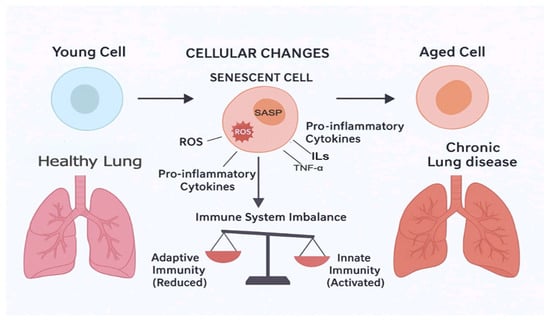
Figure 1
Open AccessArticle
Next-Generation Sequencing Reveals the Potential Role of RET Protooncogene in Metastasis Progression in Medullary Thyroid Cancer
by
Maurice Klein, Anna Julia Claudia Klein, Arnold M. Raem, Nicklas Garrelfs, Henrike J. Fischer, Frank Hölzle and Kai Wermker
Curr. Issues Mol. Biol. 2025, 47(7), 560; https://doi.org/10.3390/cimb47070560 - 18 Jul 2025
Abstract
Background: Medullary thyroid carcinoma (MTC) has a high rate of local and distant metastases. In particular, the RET protooncogene appears to be the predominant driver mutation for oncogenesis. The German S3 thyroid carcinoma guidelines recommend molecular genetic analysis of the tumour without specifying
[...] Read more.
Background: Medullary thyroid carcinoma (MTC) has a high rate of local and distant metastases. In particular, the RET protooncogene appears to be the predominant driver mutation for oncogenesis. The German S3 thyroid carcinoma guidelines recommend molecular genetic analysis of the tumour without specifying the site of the tissue sampling. Whether there is difference in RET protooncogene between the primary tumour, lymph node, and distant metastasis has not yet been investigated. However, differences could be important with regard to biopsy localization, and also, thus, the choice of single- or multi-tyrosine-kinase-inhibitor therapy. Methods: In a case of sporadic MTC, Cancer Hotspot panel diagnostics were performed on the primary tumour, lymph node metastasis, and distant metastasis. Mutations were classified using different gene databases, and the different stages of metastasis were compared. Results: RET protooncogene (chr10:43609933, c.1886_1891delTGTGCG, p.Leu629_Asp631delinsHis) was found to be present in the MTC tissue of the primary tumour, lymph node, and distant metastasis in the Cancer Hotspot Panel diagnostic, while the other investigated therapy-relevant mutational profiles were not consistently found. Conclusions: Further longitudinal studies in larger patient cohorts are required to elucidate the role of the RET protooncogene in the metastatic progression of MTC and to determine its impact on the selection of biopsy sites and the subsequent decision-making regarding single- versus multi-tyrosine kinase inhibitor therapy.
Full article
(This article belongs to the Section Bioinformatics and Systems Biology)
►▼
Show Figures
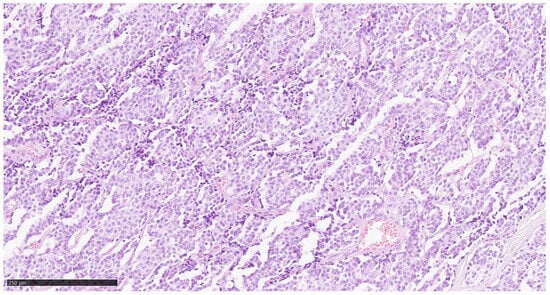
Figure 1
Open AccessReview
Atrial Fibrillation in Diabetes: Pathogenesis and Targeted Rhythm Control Strategies
by
Konstantinos Grigoriou, Paschalis Karakasis, Konstantinos Pamporis, Panagiotis Theofilis, Dimitrios Patoulias, Efstratios Karagiannidis, Barbara Fyntanidou, Antonios P. Antoniadis and Nikolaos Fragakis
Curr. Issues Mol. Biol. 2025, 47(7), 559; https://doi.org/10.3390/cimb47070559 - 17 Jul 2025
Abstract
Diabetes mellitus and atrial fibrillation (AF) frequently coexist, creating a complex bidirectional relationship that exacerbates cardiovascular risk and challenges clinical management. Diabetes fosters a profibrotic, pro-inflammatory, and proarrhythmic atrial substrate through a constellation of pathophysiologic mechanisms, including metabolic remodeling, oxidative stress, mitochondrial dysfunction,
[...] Read more.
Diabetes mellitus and atrial fibrillation (AF) frequently coexist, creating a complex bidirectional relationship that exacerbates cardiovascular risk and challenges clinical management. Diabetes fosters a profibrotic, pro-inflammatory, and proarrhythmic atrial substrate through a constellation of pathophysiologic mechanisms, including metabolic remodeling, oxidative stress, mitochondrial dysfunction, ion channel dysregulation, and autonomic imbalance, thereby promoting AF initiation and progression. Conventional rhythm control strategies remain less effective in diabetic individuals, underscoring the need for innovative, substrate-targeted interventions. In this context, sodium–glucose cotransporter 2 (SGLT2) inhibitors and glucagon-like peptide-1 (GLP-1) receptor agonists have emerged as promising agents with pleiotropic antiarrhythmic properties, modulating fibrosis, inflammation, and mitochondrial integrity. Moreover, advances in anti-inflammatory, antifibrotic, and ion channel-modulating therapeutics, coupled with novel mitochondrial-targeted strategies, are reshaping the therapeutic landscape. Multi-omics approaches are further refining our understanding of diabetes-associated AF, facilitating precision medicine and biomarker-guided interventions. This review delineates the molecular nexus linking diabetes and AF, critically appraises emerging rhythm control strategies, and outlines translational avenues poised to advance individualized management in this high-risk population.
Full article
(This article belongs to the Special Issue Advances in Molecular Therapies and Disease Associations in Diabetes)
►▼
Show Figures

Figure 1
Open AccessArticle
Evodiamine Boosts AR Expression to Trigger Senescence and Halt Proliferation in OSCC Cells
by
Gang Chen, Hong-Liang Du, Jia-Nan Liu, Jie Cheng, Jing Chen, Xiao-Yang Yin, Hu-Lai Wei and Jing Wang
Curr. Issues Mol. Biol. 2025, 47(7), 558; https://doi.org/10.3390/cimb47070558 - 17 Jul 2025
Abstract
Oral squamous cell carcinoma (OSCC), an aggressive and poorly prognosed subtype of head and neck squamous cell carcinoma (HNSCC), has prompted urgent calls for innovative therapeutic approaches. Evodiamine (EVO), a natural alkaloid extracted from the Chinese herb Evodia rutaecarpa, has demonstrated significant
[...] Read more.
Oral squamous cell carcinoma (OSCC), an aggressive and poorly prognosed subtype of head and neck squamous cell carcinoma (HNSCC), has prompted urgent calls for innovative therapeutic approaches. Evodiamine (EVO), a natural alkaloid extracted from the Chinese herb Evodia rutaecarpa, has demonstrated significant potential in curbing tumor cell proliferation and slowing tumor expansion. However, its specific effects on cell senescence within the context of OSCC have remained shrouded in uncertainty. This study delves into the mechanisms of EVO’s impact on OSCC by harnessing databases such as the Traditional Chinese Medicine Systems Pharmacology Database and Analysis Platform (TCMSP), The Cancer Genome Atlas (TCGA), the Gene Expression Omnibus (GEO), and CellAge to pinpoint potential targets and carry out in-depth bioinformatics analysis. The findings reveal that EVO can markedly enhance the expression of the androgen receptor (AR) in OSCC cells, inducing cellular senescence and thereby inhibiting tumor progression. Furthermore, the research indicates that AR expression is considerably lower in OSCC tissues than in normal tissues. This low expression of AR in tumor tissues is closely associated with advanced clinical stages and unfavorable prognoses in HNSCC patients. These discoveries open up new avenues for therapeutic strategies, and suggest that AR holds promise as a potential therapeutic target for OSCC, and EVO may amplify its antitumor effects by enhancing AR-mediated cellular senescence in the treatment of OSCC.
Full article
(This article belongs to the Section Molecular Medicine)
►▼
Show Figures
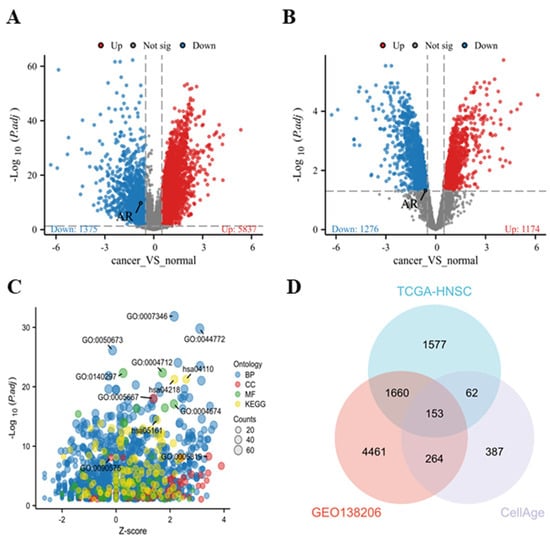
Figure 1
Open AccessArticle
MMP-9 Activation via ROS/NF-κB Signaling in Colorectal Cancer Progression: Molecular Insights and Prognostic–Therapeutic Perspectives
by
Andrej Veljkovic, Goran Stanojevic, Branko Brankovic, Stefanos Roumeliotis, Konstantinos Leivaditis, Branka Djordjevic, Xiaobo Li, Aleksandra Klisic, Jovan Hadzi-Djokic and Gordana Kocic
Curr. Issues Mol. Biol. 2025, 47(7), 557; https://doi.org/10.3390/cimb47070557 - 17 Jul 2025
Abstract
Colorectal cancer (CRC) is characterized by complex interactions between inflammation, oxidative stress, and extracellular matrix remodeling. Recent studies have highlighted the significance of the reactive oxygen species (ROS)–nuclear factor kappa B (NF-κB)–matrix metalloproteinase-9 (MMP-9) axis in promoting tumor invasion and metastasis in CRC,
[...] Read more.
Colorectal cancer (CRC) is characterized by complex interactions between inflammation, oxidative stress, and extracellular matrix remodeling. Recent studies have highlighted the significance of the reactive oxygen species (ROS)–nuclear factor kappa B (NF-κB)–matrix metalloproteinase-9 (MMP-9) axis in promoting tumor invasion and metastasis in CRC, linking oxidative stress with inflammatory signaling and extracellular matrix degradation. In this study, we analyzed the concentration of advanced oxidation protein products (AOPPs), expression of NF-κB, and the activity of MMP-9 in tumor tissue, adjacent tissue, and healthy control colon tissue. Tissue specimens were collected from 50 patients with primary CRC following surgical resection. The analyses were performed using appropriate and validated biochemical methods, including ELISA, spectrophotometry, and indirect immunofluorescence. Significantly higher levels of all three markers were observed in tumor tissue compared to controls. Additionally, adjacent tissue exhibited elevated NF-κB expression and MMP-9 activity when compared to healthy colon tissue. AOPP levels correlated strongly with MMP-9 activity, highlighting the role of oxidative stress in the activation of MMP-9. MMP-9 demonstrated the highest predictive value for CRC, emphasizing its potential as a diagnostic and theranostic marker. Our findings support the hypothesis that the ROS–NF-κB–MMP-9 axis plays an important role in CRC progression, particularly during stages T2 and T3. Targeting this pathway may offer new therapeutic strategies for limiting tumor invasion and recurrence. Moreover, ensuring adequate surgical resection margins is crucial to optimizing treatment outcomes.
Full article
(This article belongs to the Special Issue Future Challenges of Targeted Therapy of Cancers: 2nd Edition)
►▼
Show Figures

Figure 1
Open AccessReview
Protective Potential of Satureja montana-Derived Polyphenols in Stress-Related Central Nervous System Disorders, Including Dementia
by
Stela Dragomanova, Lyubka Tancheva, Silviya Abarova, Valya B. Grigorova, Valentina Gavazova, Dana Stanciu, Svetlin Tzonev, Vladimir Prandjev and Reni Kalfin
Curr. Issues Mol. Biol. 2025, 47(7), 556; https://doi.org/10.3390/cimb47070556 - 17 Jul 2025
Abstract
Satureja montana (SM) is acknowledged as a highly pharmacologically important species within the vast Lamiaceae family, indigenous to the Balkan area. Traditionally, this plant has been employed as a culinary spice, especially in Bulgarian gastronomy. Additionally, it is widely recognized that mental
[...] Read more.
Satureja montana (SM) is acknowledged as a highly pharmacologically important species within the vast Lamiaceae family, indigenous to the Balkan area. Traditionally, this plant has been employed as a culinary spice, especially in Bulgarian gastronomy. Additionally, it is widely recognized that mental health is affected by the nature and quality of dietary consumption. Results: Ethnopharmacological research underscores the potential of SM in influencing various chronic ailments, including depression and anxiety. This plant is distinguished by a rich variety of secondary metabolites that display a broad spectrum of biological activities, such as antioxidant, antidiabetic, anti-inflammatory, analgesic, antibacterial, antiviral, and antifungal effects. Particularly, two of its active phenolic compounds, rosmarinic acid and carvacrol, reveal notable anxiolytic and antidepressive properties. This review aims to explore the capacity of SM to improve mental health through its plentiful phenolic components. Recent studies indicate their efficacy in addressing Alzheimer’s-type dementia. A notable correlation exists among depression, anxiety, and cognitive decline, which includes dementia. Considering that Alzheimer’s disease (AD) is a multifaceted condition, it requires multi-targeted therapeutic strategies for both prevention and management. Conclusions: Satureja montana is recognized as potential candidate for both the prevention and management of various mental health disorders, including dementia.
Full article
(This article belongs to the Special Issue The Modulatory Effects of Plants with Therapeutic Potential in Neuropsychiatric Disorder)
►▼
Show Figures
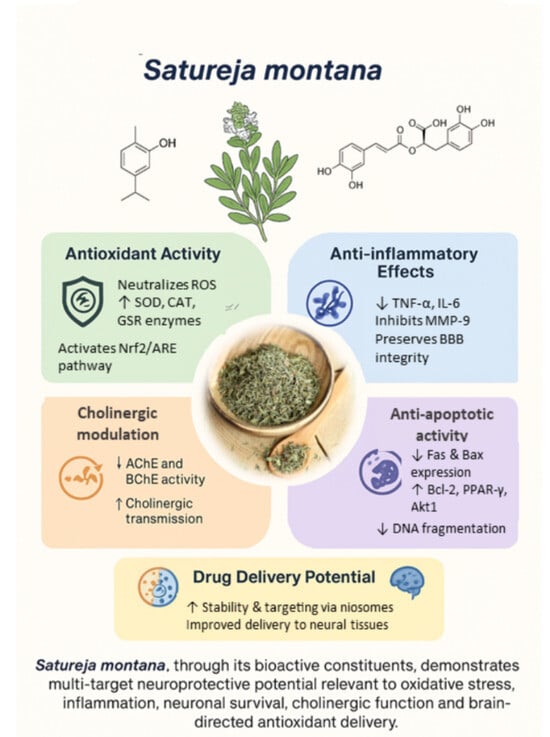
Graphical abstract
Open AccessArticle
IGFBP5 Promotes Atherosclerosis in APOE−/− Mice Through Phenotypic Transformation of VSMCs
by
Aoqi Xiang, Hua Guan, Peihong Su, Lusha Zhang, Xiaochang Chen and Qi Yu
Curr. Issues Mol. Biol. 2025, 47(7), 555; https://doi.org/10.3390/cimb47070555 - 17 Jul 2025
Abstract
Atherosclerosis constitutes a pathological process underlying cardiovascular diseases. There is growing evidence that IGFBP5 is a causative factor, although the conclusions of different studies are inconsistent. The present study aims to confirm the role and mechanism of IGFBP5 in atherosclerosis. The expression of
[...] Read more.
Atherosclerosis constitutes a pathological process underlying cardiovascular diseases. There is growing evidence that IGFBP5 is a causative factor, although the conclusions of different studies are inconsistent. The present study aims to confirm the role and mechanism of IGFBP5 in atherosclerosis. The expression of IGFBP5 was induced in the skeletal muscle of male ApoE−/− mice, an atherosclerosis model, using adeno-associated virus, resulting in elevated circulating IGFBP5 levels. Changes in blood lipids were detected, and pathological changes in the aorta were observed. Analysis of IGFBP5 function using RNA sequencing and validation were performed in a mouse aortic smooth muscle cell line. The results demonstrated that IGFBP5 overexpression exacerbated the development of aortic lesions in this murine models without any discernible alterations in lipid profile parameters; the arterial transcriptomic landscape revealed that heightened IGFBP5 levels predominantly influenced pathways governing smooth muscle cell proliferation and motility. In vitro experimentation corroborated these findings, showcasing the stimulatory effect of IGFBP5 on VSMC (vascular smooth muscle cell) proliferation and migration, provoking a transition toward a proliferative phenotype. IGFBP5 promotes atherosclerosis in ApoE−/− mice through the phenotypic transformation of VSMCs. This finding suggests that IGFBP5 has the potential to serve as an indicator of atherosclerosis diagnosis and a target for therapeutic interventions in the future.
Full article
(This article belongs to the Special Issue Molecules at Play in Cardiovascular Diseases)
►▼
Show Figures

Graphical abstract
Open AccessReview
Epigenetic Mechanisms in Apis melifera: From Development to Environmental Adaptation
by
Xiexin Hu, Jing Xu and Kang Wang
Curr. Issues Mol. Biol. 2025, 47(7), 554; https://doi.org/10.3390/cimb47070554 - 17 Jul 2025
Abstract
Epigenetics, as an important scientific field that bridges genomic function and phenotypic plasticity, increasingly demonstrates its value in bee research. In recent years, with the rapid development of omics technologies, there have been significant advancements in the study of epigenetics in honeybees. This
[...] Read more.
Epigenetics, as an important scientific field that bridges genomic function and phenotypic plasticity, increasingly demonstrates its value in bee research. In recent years, with the rapid development of omics technologies, there have been significant advancements in the study of epigenetics in honeybees. This article reviews the role of epigenetic regulation in the development, behavioral regulation, and immune response of honeybee larvae from the perspectives of DNA methylation, histone modification, and non-coding RNA. With the continuous deepening of related research, honeybee epigenetics not only opens new paths for understanding the formation mechanisms of complex traits in social insects but also provides solid theoretical support and innovative perspectives for the study of social insects and beekeeping practices. These insights also inform sustainable beekeeping practices.
Full article
(This article belongs to the Section Biochemistry, Molecular and Cellular Biology)
►▼
Show Figures
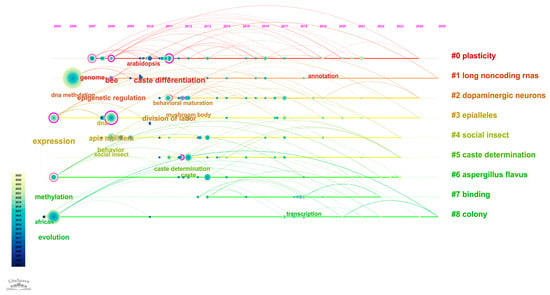
Figure 1
Open AccessArticle
Assembly and Comparative Analysis of Complete Mitochondrial Genome Sequence of Endangered Medicinal Plant Trichopus zeylanicus
by
Biju Vadakkemukadiyil Chellappan, P. R. Shidhi, Anu Sasi, Rashid Ismael Hag Ibrahim and Hamad Abu Zahra
Curr. Issues Mol. Biol. 2025, 47(7), 553; https://doi.org/10.3390/cimb47070553 - 16 Jul 2025
Abstract
Plant mitochondrial genomes exhibit extensive size variability and structural complexity. Here, we report the complete mitochondrial genome of Trichopus zeylanicus, an endemic medicinal plant from the Western Ghats. The mitochondrial genome was assembled using a combination of Illumina short-read and PacBio long-read
[...] Read more.
Plant mitochondrial genomes exhibit extensive size variability and structural complexity. Here, we report the complete mitochondrial genome of Trichopus zeylanicus, an endemic medicinal plant from the Western Ghats. The mitochondrial genome was assembled using a combination of Illumina short-read and PacBio long-read sequencing technologies, followed by extensive annotation and comparative analysis. The circular mitogenome spans 709,127 bp with a GC content of 46%, encoding 32 protein-coding genes, 17 tRNAs, and three rRNAs. Comparative analysis with other monocot mitochondrial genomes revealed conserved gene clusters but also significant lineage-specific rearrangements. Despite genome size similarities, T. zeylanicus displayed marked divergence in gene order, suggesting that genome size does not necessarily correlate with structural conservation. The genome contains 6.7% chloroplast-derived sequences and 324 predicted RNA-editing sites, predominantly in the first and second codon positions. Phylogenetic analysis based on mitochondrial genes placed T. zeylanicus as a distinct lineage within Dioscoreales, supporting its evolutionary uniqueness. This work provides the first mitogenomic resource for Dioscoreales and advances our understanding of mitochondrial diversity and evolution in monocots.
Full article
(This article belongs to the Special Issue Technological Advances Around Next-Generation Sequencing Application)
►▼
Show Figures

Graphical abstract
Open AccessArticle
A Novel Hypoxia-Immune Signature for Gastric Cancer Prognosis and Immunotherapy: Insights from Bulk and Single-Cell RNA-Seq
by
Mai Hanh Nguyen, Hoang Dang Khoa Ta, Doan Phuong Quy Nguyen, Viet Huan Le and Nguyen Quoc Khanh Le
Curr. Issues Mol. Biol. 2025, 47(7), 552; https://doi.org/10.3390/cimb47070552 - 16 Jul 2025
Abstract
Background: Hypoxia and immune components significantly shape the tumor microenvironment and influence prognosis and immunotherapy response in gastric cancer (GC). This study aimed to develop hypoxia- and immune-related gene signatures for prognostic evaluation in GC. Methods: Transcriptomic data from TCGA-STAD were
[...] Read more.
Background: Hypoxia and immune components significantly shape the tumor microenvironment and influence prognosis and immunotherapy response in gastric cancer (GC). This study aimed to develop hypoxia- and immune-related gene signatures for prognostic evaluation in GC. Methods: Transcriptomic data from TCGA-STAD were integrated with hypoxia- and immune-related genes from InnateDB and MSigDB. A prognostic gene signature was constructed using Cox regression analyses and validated on an independent GSE84437 cohort and single-cell RNA dataset. We further analyzed immune cell infiltration, molecular characteristics of different risk groups, and their association with immunotherapy response. Single-cell RNA-seq data from the TISCH database were used to explore gene expression patterns across cell types. Results: Five genes (TGFB3, INHA, SERPINE1, GPC3, SRPX) were identified. The risk score effectively stratified patients by prognosis, with the high-risk group showing lower overall survival and lower T-cell expression. The gene signature had an association with immune suppression, ARID1A mutation, EMT features, and poorer response to immunotherapy. Gene signature, especially SRPX was enriched in fibroblasts. Conclusions: We developed a robust hypoxia- and immune-related gene signature that predicts prognosis and may help guide immunotherapy strategies for GC patients.
Full article
(This article belongs to the Special Issue Linking Genomic Changes with Cancer in the NGS Era, 2nd Edition)
►▼
Show Figures

Figure 1
Open AccessArticle
Bioinformatics Analysis and Functional Verification of Phytoene Synthase Gene PjPSY1 of Panax japonicus C. A. Meyer
by
Tingting Tang, Rui Jin, Xilun Huang, E Liang and Lai Zhang
Curr. Issues Mol. Biol. 2025, 47(7), 551; https://doi.org/10.3390/cimb47070551 - 16 Jul 2025
Abstract
Phytoene synthase (PSY) is a multimeric enzyme that serves as the first enzyme in carotenoid synthesis within plant tissues and plays a crucial role in the production of carotenoids in plants. To understand the function of the PSY gene in Panax japonicus C.
[...] Read more.
Phytoene synthase (PSY) is a multimeric enzyme that serves as the first enzyme in carotenoid synthesis within plant tissues and plays a crucial role in the production of carotenoids in plants. To understand the function of the PSY gene in Panax japonicus C. A. Meyer. fruit, the gene’s transcript was obtained by analyzing the transcriptome sequencing data of Panax japonicus fruit. The CDS sequence of the gene was cloned from Panax japonicus fruit using the RT-PCR cloning technique and named PjPSY1, which was then subjected to biosynthetic analysis and functional verification. The results showed that the open reading frame of the gene was 1269 bp, encoding 423 amino acids, with a protein molecular mass of 47,654.67 KDa and an isoelectric point (pI) of 8.63; the protein encoded by these amino acids was hydrophilic and localized in chloroplasts, and its three-dimensional structure was predicted by combining the pymol software to annotate the N site of action and active centre of the protein. Phylogenetic analysis demonstrated that PjPSY1 had the closest affinity to DcPSY from Daucus carota. Overexpression of PjPSY1 led to a significant increase in the content of carotenoid-related monomers in Arabidopsis thaliana, with Violaxanthin being synthesized in transgenic Arabidopsis thaliana but not in wild-type Arabidopsis thaliana. The PjPSY1 clone obtained in this study was able to promote carotenoid synthesis in the fruits of Panax japonicus, revealing that the mode of action of PjPSY1 in the carotenoid biosynthesis pathway of Panax japonicus fruits has a positive regulatory effect.
Full article
(This article belongs to the Section Bioinformatics and Systems Biology)
►▼
Show Figures

Figure 1
Open AccessArticle
Erythroblasts Promote the Development of a Suppressive Lymphocyte Phenotype via Treg Induction and PD1 Upregulation on the Surfaces of B-Cells: A Study on the Subpopulation-Specific Features of Erythroblasts
by
Kirill Nazarov, Roman Perik-Zavodskii, Julia Shevchenko and Sergey Sennikov
Curr. Issues Mol. Biol. 2025, 47(7), 550; https://doi.org/10.3390/cimb47070550 - 15 Jul 2025
Abstract
This study identifies the novel effects of soluble factors derived from murine erythroblasts on lymphoid cell phenotypes. These effects were observed following the treatment of splenic mononuclear cells with erythroblast-conditioned media received from both healthy mice and mice subjected to hematopoiesis-activating conditions (hypoxia,
[...] Read more.
This study identifies the novel effects of soluble factors derived from murine erythroblasts on lymphoid cell phenotypes. These effects were observed following the treatment of splenic mononuclear cells with erythroblast-conditioned media received from both healthy mice and mice subjected to hematopoiesis-activating conditions (hypoxia, blood loss, and hemolytic anemia), suggesting a common mechanism of action. Using flow cytometry, we elucidated that erythroblast-derived soluble products modulate T cell differentiation by promoting Treg development and increasing PD-1 surface expression on B cells. The immunoregulatory potential of erythroblasts is subpopulation-dependent: CD45+ erythroblasts respond to hemolytic stress by upregulating the surface expression of immunosuppressive molecules PDL1 and Galectin-9, while CD45- erythroblasts primarily increase TGFb production. These findings highlight the regulatory role of erythroblasts in modulating immune responses.
Full article
(This article belongs to the Section Biochemistry, Molecular and Cellular Biology)
►▼
Show Figures

Figure 1

Journal Menu
► ▼ Journal MenuJournal Browser
► ▼ Journal Browser-
arrow_forward_ios
Forthcoming issue
arrow_forward_ios Current issue - Volumes not published by MDPI
- Vol. 42 (2021)
- Vol. 41 (2021)
- Vol. 40 (2021)
- Vol. 39 (2020)
- Vol. 38 (2020)
- Vol. 37 (2020)
- Vol. 36 (2020)
- Vol. 35 (2020)
- Vol. 34 (2019)
- Vol. 33 (2019)
- Vol. 32 (2019)
- Vol. 31 (2019)
- Vol. 30 (2019)
- Vol. 29 (2018)
- Vol. 28 (2018)
- Vol. 27 (2018)
- Vol. 26 (2018)
- Vol. 25 (2018)
- Vol. 24 (2017)
- Vol. 23 (2017)
- Vol. 22 (2017)
- Vol. 21 (2017)
- Vol. 20 (2016)
- Vol. 19 (2016)
- Vol. 18 (2016)
- Vol. 17 (2015)
- Vol. 16 (2014)
- Vol. 15 (2013)
- Vol. 14 (2012)
- Vol. 13 (2011)
- Vol. 12 (2010)
- Vol. 11 (2009)
- Vol. 10 (2008)
- Vol. 9 (2007)
- Vol. 8 (2006)
- Vol. 7 (2005)
- Vol. 6 (2004)
- Vol. 5 (2003)
- Vol. 4 (2002)
- Vol. 3 (2001)
- Vol. 2 (2000)
- Vol. 1 (1999)
Highly Accessed Articles
Latest Books
E-Mail Alert
News
Topics
Topic in
Brain Sciences, CIMB, Epigenomes, Genes, IJMS, DNA
Genetics and Epigenetics of Substance Use Disorders
Topic Editors: Aleksandra Suchanecka, Anna Maria Grzywacz, Kszysztof ChmielowiecDeadline: 15 November 2025
Topic in
Animals, CIMB, Genes, IJMS, DNA
Advances in Molecular Genetics and Breeding of Cattle, Sheep, and Goats
Topic Editors: Xiukai Cao, Hui Li, Huitong ZhouDeadline: 30 November 2025
Topic in
Biophysica, CIMB, Diagnostics, IJMS, IJTM
Molecular Radiobiology of Protons Compared to Other Low Linear Energy Transfer (LET) Radiation
Topic Editors: Francis Cucinotta, Jacob RaberDeadline: 20 December 2025
Topic in
BioTech, DNA, Genes, IJMS, CIMB
Single-Cell Technologies: From Research to Application
Topic Editors: Ken-Hong Lim, Chung-Der Hsiao, Pei-Ming YangDeadline: 31 December 2025

Conferences
26–29 August 2025
The 5th International Symposium on Frontiers in Molecular Science
Molecular Regulatory Mechanisms of Biological Function and Drug Discovery based on Protein Structure/Function Analysis
Molecular Regulatory Mechanisms of Biological Function and Drug Discovery based on Protein Structure/Function Analysis

Special Issues
Special Issue in
CIMB
Molecular Mechanism and Advances in Gynecological Pathology: From Bench to Bedside
Guest Editor: Ahsanullah UnarDeadline: 20 July 2025
Special Issue in
CIMB
Cellular and Molecular Biology Insights into Neurodegenerative Diseases: From Pathogenesis to Therapeutic Targets
Guest Editors: Michela Pecoraro, Silvia FranceschelliDeadline: 31 July 2025
Special Issue in
CIMB
The Molecular Basis of Genetic and Epigenetic Changes in Cancer
Guest Editor: Su Yon JungDeadline: 31 July 2025
Special Issue in
CIMB
Pharmacological Activities and Mechanisms of Action of Natural Products
Guest Editors: Shining Loo, Antony Kam, Lee Simon Ming-YuenDeadline: 31 July 2025
Topical Collections
Topical Collection in
CIMB
Feature Papers in Current Issues in Molecular BiologyCollection Editor: Madhav Bhatia
Topical Collection in
CIMB
Molecular Mechanisms in Human Diseases
Collection Editor: Roberto Campagna
Topical Collection in
CIMB
Feature Papers Collection in Molecular Microbiology
Collection Editor: Bruce Seal
Topical Collection in
CIMB
Advancements in Molecular Biology and Pharmaceutical Science
Collection Editor: Arun Butreddy







